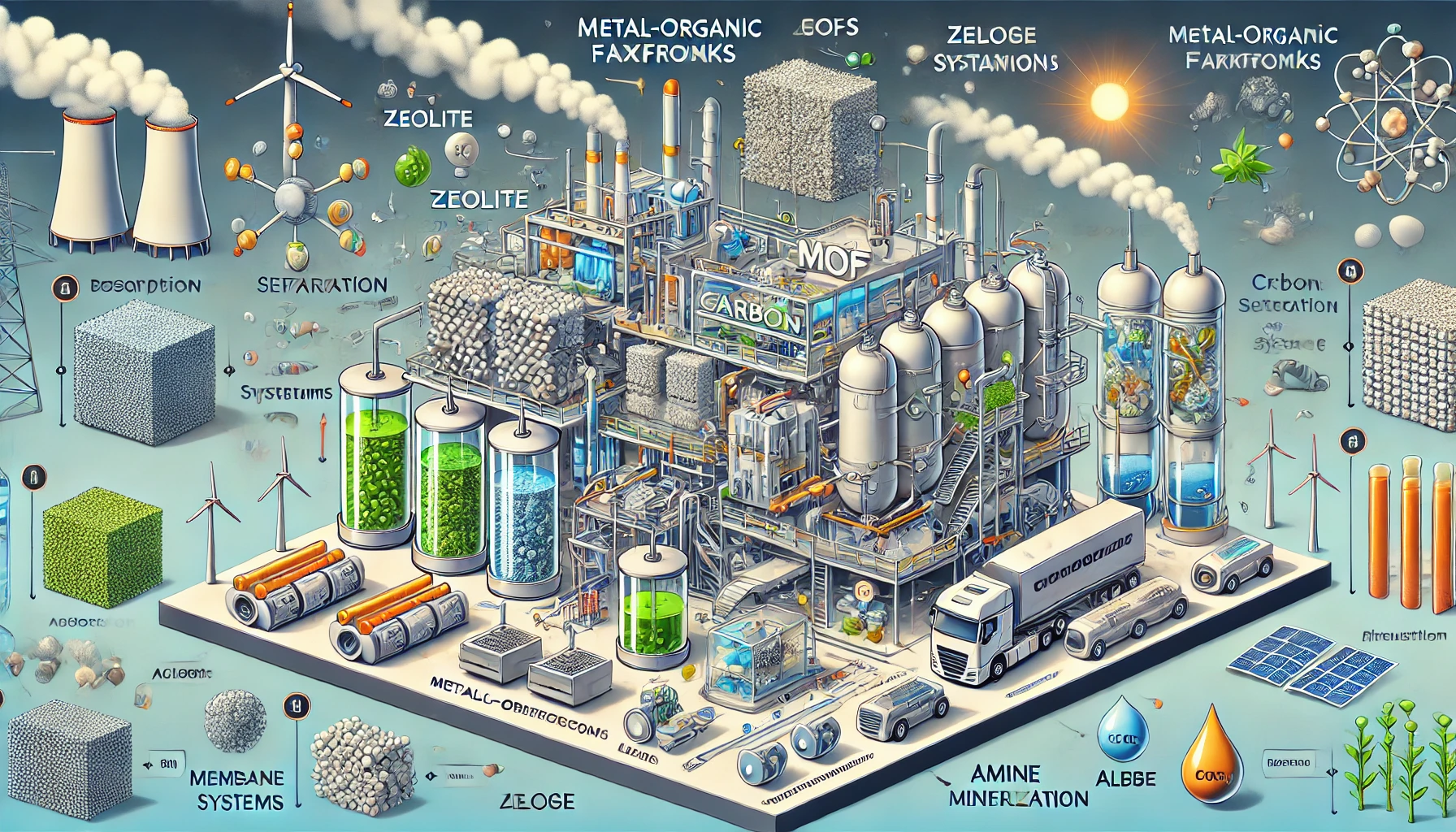Addressing Carbon Emissions: An Urgent Priority
The global community faces increasing climate change impacts, making the reduction of carbon emissions imperative. Carbon capture and storage (CCS) is vital in lowering greenhouse gas levels. Rapid advancements in carbon-capturing materials and methods offer promising solutions. This article delves into key materials, innovative processes, and their potential impact on carbon capture.
1. Understanding Carbon Capture and Its Significance
Carbon capture and storage (CCS) involves trapping carbon dioxide (CO₂) emissions before they enter the atmosphere, transporting them to a storage site, and isolating them long-term. CCS is crucial in decreasing CO₂ concentration, a major greenhouse gas driving climate change. According to the International Energy Agency (IEA), achieving climate goals requires cutting CO₂ emissions by 45% by 2030 and reaching net zero by 2050.
2. Key Carbon-Capturing Materials
Research on effective carbon-capturing materials is a priority in CCS. Here are some promising materials currently in use or development:
Metal-Organic Frameworks (MOFs)
MOFs are porous materials made of metal ions and organic molecules, offering a large surface area and adjustable structure ideal for capturing and storing CO₂. Some MOFs can selectively absorb CO₂ and convert it into other chemicals, adding value to captured carbon.
Zeolites
Zeolites, naturally occurring minerals with a porous, crystalline structure, are effective in capturing CO₂ due to their high affinity for the gas. They have been used in industrial processes for years and remain essential in CCS for their efficiency and low cost.
Amine-based Solvents
Amines, nitrogen-containing compounds, have a strong affinity for CO₂ and are commonly used in carbon capture processes, especially in power plants. Chemical absorption with amines involves binding CO₂ with a solvent, which is then heated to release CO₂ for collection and storage.
Nanomaterials
Nanomaterials, such as carbon nanotubes and graphene, offer unique properties for carbon capture. They can be used in membranes for gas separation, enhancing CO₂ capture efficiency. Their structure and reactivity allow functionalization to improve CO₂ absorption.
Algae and Biochar
Algae absorb CO₂ during growth, converting it into biomass. Biochar, a stable form of carbon produced from organic material, can store CO₂ for centuries when used in soil. Algae and biochar not only capture and store carbon but also improve soil quality in agricultural applications.
3. Processes for Carbon Capture
Various processes, often combined with advanced materials, are used in carbon capture. Here’s an overview of some key methods:
Absorption
Absorption, one of the most common carbon capture methods, often involves amine-based solutions. This process captures CO₂ from flue gases by dissolving it in a liquid solvent. The CO₂-rich solvent is then heated to release the gas for storage or reuse.
Adsorption
Adsorption-based capture uses solid materials like MOFs and zeolites, capturing CO₂ on their surface. Adsorption operates at lower pressures and temperatures, potentially being more energy-efficient than absorption.
Membrane Separation
Membranes are used to separate CO₂ from other gases in industrial emissions. By allowing only specific molecules to pass through, these membranes concentrate CO₂ for capture. Nanomaterials improve the selectivity and permeability of membranes, increasing their efficiency.
Conclusion
In conclusion, innovations in carbon-capturing materials and processes are crucial in the fight against climate change. Continued research and development in this field will enhance our ability to reduce carbon emissions and mitigate their impact on the environment.
Cryogenic Distillation
Cryogenic distillation cools gas mixtures to very low temperatures to separate and condense CO₂ from other gases. Though it uses a lot of energy, it is quite effective for streams with high CO₂ concentrations. This method is often employed in natural gas processing industries.
Direct Air Capture (DAC)
DAC captures CO₂ directly from the ambient air, unlike other methods that capture it from concentrated sources. This process typically uses chemical adsorbents to trap CO₂, making it scalable for reducing atmospheric carbon levels. However, DAC systems currently need a lot of energy, and ongoing research aims to improve their energy efficiency.
Carbon Storage and Utilization
Once CO₂ is captured, it needs to be stored or utilized. Storage options include:
- Geological Storage: Injecting CO₂ into deep underground rock formations, such as depleted oil and gas fields, where it stays isolated from the atmosphere.
- Mineralization: Reacting CO₂ with minerals like magnesium and calcium silicates to form stable carbonates. This provides a permanent storage solution and can even produce building materials.
- Ocean Storage: Dissolving CO₂ in the ocean or injecting it into deep ocean water. However, this method raises environmental concerns due to its potential impact on marine ecosystems.
On the utilization side, researchers are exploring ways to convert captured CO₂ into useful products, such as:
- Chemicals and Fuels: CO₂ can be transformed into chemicals like methanol or fuels like synthetic gasoline through catalytic processes, offering a sustainable source of products while reducing emissions.
- Building Materials: CO₂ can be used to produce concrete and other construction materials, where it becomes permanently stored, reducing emissions from the carbon-intensive construction industry.
Challenges and Future Directions
Despite the vast potential of carbon-capturing materials and processes, several challenges remain:
- Energy Requirements: Many capture processes, especially DAC, require a lot of energy, which can increase costs and emissions unless sourced from renewables.
- Cost: Developing and scaling carbon capture technologies is expensive, and for many industries, it remains cost-prohibitive without government incentives.
- Material Longevity and Efficiency: Carbon-capturing materials need to be durable and efficient over long periods to be viable in industrial settings. Research is ongoing to improve the longevity and capacity of materials like MOFs and nanomaterials.
Emerging Innovations and Technologies
Several new approaches are emerging in carbon capture research:
- Electrochemical and Photocatalytic Reduction: These methods aim to convert CO₂ into useful products using renewable energy sources, such as solar or wind. Photocatalysts use sunlight to drive the conversion, offering a low-energy pathway for CO₂ utilization.
- Hybrid Materials: Combining different materials, like MOFs with amine solutions, can enhance capture efficiency. These hybrid materials are engineered to take advantage of the properties of multiple components.
- Artificial Photosynthesis: Inspired by plants, artificial photosynthesis aims to capture CO₂ and convert it into fuel using sunlight. While still in the early stages, this technology holds promise as a sustainable carbon capture method.
Policies and Economic Incentives
Governments play a crucial role in accelerating the adoption of CCS through policies and incentives. Carbon pricing, tax credits, and direct subsidies can make CCS more financially viable. For example, in the United States, the 45Q tax credit provides financial incentives for companies that capture and store or utilize CO₂. International agreements, like the Paris Agreement, also emphasize the importance of CCS in achieving global climate goals. # The Role of Carbon Capture in a Sustainable Future
Carbon capture, when integrated with renewable energy sources and efforts to cut emissions, can play a vital role in lowering CO₂ levels in the atmosphere. Although tackling climate change requires a combination of approaches, CCS offers a way for high-emission industries, like steel and cement, to lessen their ecological footprint. Moreover, breakthroughs in carbon utilization can open up new markets and generate additional revenue, boosting interest and investment in CCS technologies.
Conclusion
Materials and techniques for capturing carbon are crucial for meeting global climate goals. Progress in MOFs, zeolites, and nanomaterials, along with methods like DAC and membrane separation, are driving the carbon capture field forward. Although there are hurdles, such as high costs and energy requirements, ongoing research, supportive policies, and technological advancements can establish CCS as a key element in the fight against climate change. As these technologies advance, they hold promise for a future where carbon emissions are effectively controlled and reduced.







Leave a Reply